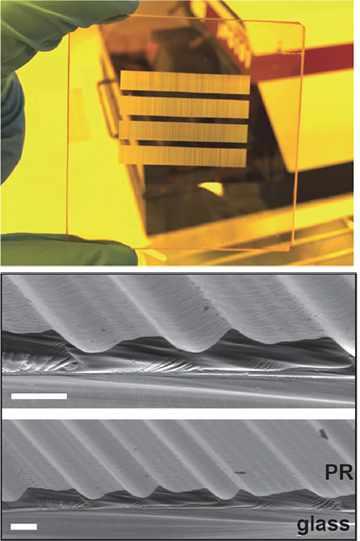 (Top) Photograph of a set of four SADLs. (Bottom) Scanning electron micrographs showing the microstructure of the lenses fabricated via grayscale optical lithography on glass (scale bars: 5 µm).
(Top) Photograph of a set of four SADLs. (Bottom) Scanning electron micrographs showing the microstructure of the lenses fabricated via grayscale optical lithography on glass (scale bars: 5 µm).
Lenses are essential components in cameras, microscopes, telescopes and other imaging systems. Refractive lenses tend to be bulky due to their curvature; diffractive lenses can be planar, but suffer from debilitating chromatic aberrations—different colors focus at different locations, leading to poor imaging performance.
Recently, we have used computational techniques to design, fabricate and characterize flat, multi-level diffractive lenses that can focus three or more wavelengths of light at the same location. We call these super-achromatic diffractive lenses (SADLs).1 These lenses extend previously demonstrated non-imaging diffractive optics developed for spectrum-splitting and solar concentration.2,3
In the past, hybrid refractive-diffractive lenses (for example, harmonic diffractive lenses) have shown achromatic focusing. However, these devices require thicknesses much larger than the wavelength and, hence, cannot be considered thin or planar. This is due to the fundamental requirement of matching the phase at multiple wavelengths using harmonics of 2π, for instance. Moreover, the refractive-diffractive approach is limited to a discrete number of wavelengths.
Our multi-level broadband diffractive lenses—with a maximum thickness of approximately 3 µm—are fundamentally different. We believe that our SADLs constitute the first demonstration of super-achromatic focusing with such a thin lens in a single material. We achieve this by not insisting on strict phase matching for all wavelengths, but instead optimizing the spectral-phase distribution to maximize focusing efficiency. Furthermore, we take fabrication constraints directly into account during the design process, which allows for robust devices.
Subwavelength structures on surfaces have also recently been used to create achromatic planar lenses.4 These “metalenses” achieve abrupt phase shifts via resonance effects. The metalenses, however, are more complex to fabricate than SADLs: whereas SADLs require features that are greater than 5λ and aspect ratios of 1:1, metalenses require features 0.065λ in size and aspect ratios of 3:1 or higher. Furthermore, SADLs can be polarization insensitive—an important advantage for applications in imaging—while the resonant nature of the metalenses makes them generally polarization sensitive. Diffractive optics are sufficient to manipulate the scalar properties of light, such intensity, spectrum and light field, and are considerably simpler to manufacture over large areas cost-effectively using imprint processes, due to their much simpler geometries. On the other hand, metasurfaces are necessary if one wants to manipulate vector properties of light, such as polarization.5
We believe that our flat, diffractive lenses, which can be manufactured using low-cost imprinting techniques, could prove widely applicable—especially where restricted form factor is an important consideration, as in devices for augmented reality, virtual reality and advanced displays.
Researchers
Peng Wang, Nabil Mohammad and Rajesh Menon, University of Utah, Salt Lake City, Utah, USA
References
1. P. Wang et al. Sci. Rep. 6, 21545 (2016).
2. N. Mohammad et al. Opt. Express 22, A1519 (2014).
3. P. Wang et al. Prog. Photov. 23, 1073 (2014).
4. F. Aieta et al. Science 347, 1342 (2015).
5. B. Shen et al. Optica 1, 356 (2014).
